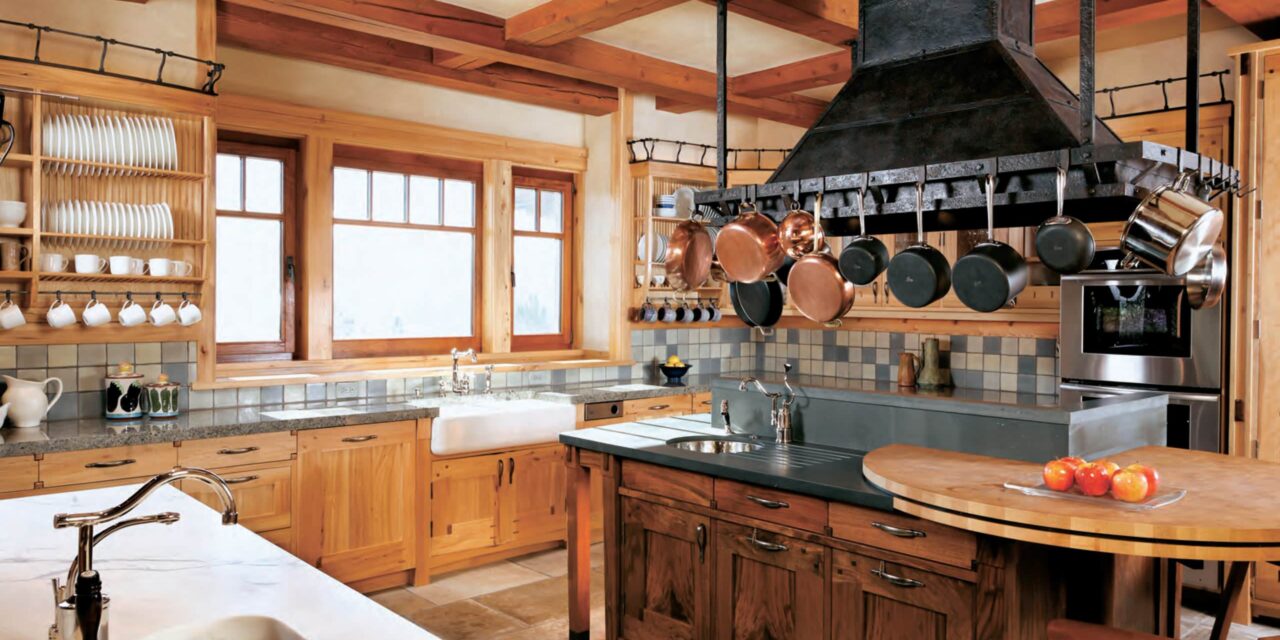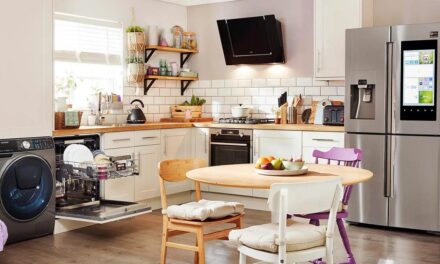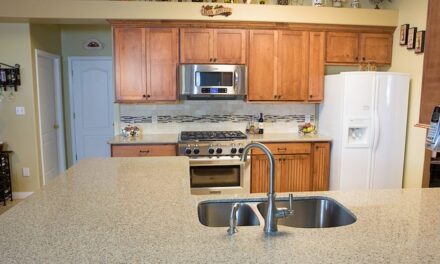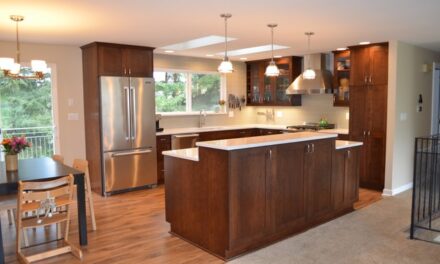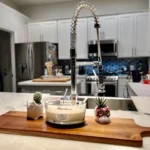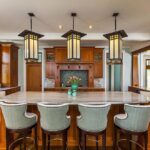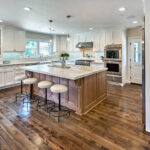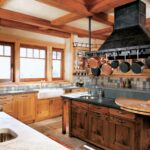Designing a mountain home kitchen is about more than just creating a space for cooking—it’s about crafting a functional, cozy hub that brings the natural beauty of the mountains into your everyday life. In these high-altitude environments, a kitchen becomes the heart of the home, a place where family and friends gather to share meals, stories, and warmth. Whether you’re whipping up hearty meals after a day of hiking or simply savoring a cup of coffee while admiring the view, every element in the kitchen plays a role in elevating both function and ambiance.
From rustic wood beams and stone countertops to modern appliances seamlessly integrated into the space, a well-designed mountain kitchen blends the rugged charm of the outdoors with the practicality of contemporary living. Smart storage solutions, energy-efficient fixtures, and durable materials that withstand both time and nature’s elements are key to making your kitchen a haven. When planning your mountain home the goal is to create an inviting environment that fosters connection while reflecting the majestic landscape that surrounds it.
Elevated Flavors: Crafting a Functional Mountain Home Kitchen
This guide will walk you through the key elements that go into creating a mountain home kitchen that not only looks great but also stands up to the demands of mountain living.For more information visit here
Table of Contents
Understanding the Mountain Environment
Before diving into design choices, it’s essential to understand the environment you’re working in. Mountain homes face specific challenges that can affect your kitchen design.
High-Altitude Cooking Considerations
Cooking at higher altitudes affects more than just baking times; it can also influence how appliances perform. Water boils at a lower temperature, which can impact boiling and simmering times, and high-altitude conditions can sometimes make gas appliances less efficient. Make sure to choose appliances that account for these challenges, such as pressure cookers or convection ovens that adjust to altitude.
Temperature Fluctuations
Mountain homes are often subject to drastic temperature changes, with cold winters and warmer summers. This can affect your kitchen’s materials and design. Durable materials that can withstand expansion and contraction due to temperature shifts are essential for a long-lasting kitchen.
Insulation and Ventilation
Given the colder climate, good insulation is key, especially in a kitchen where you’ll be using heat-generating appliances. Likewise, proper ventilation is crucial to prevent moisture buildup, which can lead to mold, especially in colder, humid mountain environments.
Selecting the Right Materials
Materials play a critical role in how your mountain home kitchen performs over time. In a mountain home, you’ll want to choose materials that are not only beautiful but also durable and easy to maintain.
Countertops: Stone, Granite, and Quartz
Natural stone materials like granite or quartz are excellent choices for countertops in a mountain home. These materials are not only stunning but also durable and easy to clean. Stone countertops also have a natural, earthy aesthetic that complements the rugged mountain environment.
Granite, for example, can withstand the weight of heavy cookware and resist heat, making it perfect for a mountain kitchen. Quartz, while man-made, offers a similar aesthetic to granite but requires less maintenance, as it doesn’t need sealing and is non-porous, preventing bacteria growth.
Flooring: Hardwood, Tile, and Slate
The flooring in a mountain home kitchen should be tough and able to withstand heavy foot traffic, muddy boots, and the occasional spill. Hardwood floors add warmth and charm, but make sure to choose a wood that can handle the humidity and temperature fluctuations of mountain environments, such as hickory or oak.
For a more rustic look, stone tiles or slate floors are a great option. Not only are they incredibly durable, but they also provide a natural feel that fits seamlessly into a mountain home kitchen. Heated floors can also be a valuable addition, adding warmth and comfort during cold months.
Backsplash: Rustic Tiles or Natural Stone
The backsplash is a chance to incorporate mountain-inspired materials without sacrificing practicality. Consider using rustic tiles or natural stone that echoes the textures of the surrounding landscape. Copper or stainless steel can add a modern twist while remaining functional and easy to clean.
Functional Layout: Maximizing Space and Flow
In a mountain home kitchen, maximizing space and ensuring a smooth workflow are essential, especially when dealing with smaller or more confined areas.
Open Concept Design
Open concept kitchens are increasingly popular in mountain home kitchen because they create a sense of space and invite the outdoors in. Large windows that offer mountain views and connect the kitchen to the living or dining areas make the space feel more expansive.
Consider an island or a large peninsula for added counter space, which also doubles as a gathering spot for friends and family. The open layout allows for seamless movement between cooking, dining, and relaxing.
Work Zones
Breaking your mountain home kitchen into zones for specific tasks can streamline cooking and entertaining. Create dedicated areas for food prep, cooking, and clean-up. This could include a prep sink near your refrigerator for easy access to fresh ingredients, a large stove area for serious cooking, and a dishwashing zone that is tucked away but still close to the action.
The work triangle—arranging your sink, stove, and refrigerator in a triangular layout—remains an effective strategy for ensuring efficiency in a mountain kitchen. However, depending on the space, adapting this into a more zone-based layout may offer greater flexibility.
Ample Storage Solutions
mountain home kitchen often serve as retreats, meaning you’ll want to make the most of your storage space to accommodate guests or large family gatherings. Consider deep cabinets, pull-out drawers, and ceiling-high storage to make the most of your space. For a more rustic look, open shelving can also be used to showcase crockery and other essentials.
Incorporate a pantry for non-perishables that can be stored for long periods. Since trips to the grocery store may be infrequent in remote mountain areas, having extra storage for dry goods is essential.
Appliance Selection for Mountain Living
The appliances you choose will play a significant role in how functional and efficient your mountain home kitchen is.
Energy Efficiency
Since many mountain homes are located in remote areas, energy efficiency is key. Choosing appliances with high energy ratings will not only lower your utility bills but also reduce your home’s environmental footprint. Look for Energy Star-rated appliances for both your cooking and refrigeration needs.
High-Altitude Specific Appliances
Certain appliances perform better at high altitudes. Gas stoves, for instance, may require adjustment to ensure that they burn efficiently at higher elevations. Similarly, you might need a pressure cooker for faster meal prep, as water boils at a lower temperature in high altitudes, affecting cooking times.
Wood Stoves and Fireplaces
For the ultimate mountain home kitchen vibe, consider installing a wood-burning stove or a kitchen fireplace. Not only do these appliances add to the rustic charm of a mountain home, but they can also provide additional heat during cold months. If cooking over an open flame appeals to you, a wood-burning stove can add an authentic, homestead-style cooking experience to your kitchen.
Lighting: Blending Ambiance with Functionality
Lighting in a mountain home kitchen needs to strike a balance between functionality and ambiance. You’ll need bright, task-specific lighting for cooking but also softer, ambient lighting to create a warm and inviting atmosphere.
Natural Light
Mountain homes often have large windows to take advantage of breathtaking views, which can also flood the kitchen with natural light. Skylights or clerestory windows can bring in even more sunlight, making your kitchen feel open and airy.
Layered Lighting
In addition to natural light, layered lighting helps ensure every part of the kitchen is well-lit. Recessed ceiling lights or pendant lights over the island can provide task lighting, while under-cabinet lights are great for illuminating workspaces.
To create a cozy, mountain-home feel, consider incorporating warm-toned light bulbs. Dimmers can also help you adjust the ambiance based on the time of day or occasion.
Incorporating Mountain Aesthetics
Beyond functionality, the aesthetics of your kitchen should reflect the surrounding environment. A mountain home is the perfect canvas for integrating natural, rustic elements into your design.
Wood and Stone
Wood and stone are the foundations of any mountain home kitchen. Exposed wooden beams, stone walls, and hardwood cabinets contribute to the rustic charm of the space. Reclaimed wood is a popular option for cabinets, as it adds both sustainability and a weathered look that fits the mountain aesthetic.
Stone, whether used in countertops, flooring, or walls, brings the ruggedness of the outdoors inside. For a modern twist, try combining stone with sleek, contemporary elements like stainless steel appliances or minimalist hardware.
Earthy Color Palette
Choosing a color palette that reflects the natural surroundings is key to achieving a cohesive look. Earthy tones like browns, greens, and muted blues work well, along with warm neutrals such as beige and cream. These colors not only tie in with the outdoor landscape but also create a calming, inviting atmosphere.
Natural Textures
Incorporating natural textures into your mountain home kitchen design enhances the mountain feel. Rough-hewn wood, textured stone, and woven textiles create a tactile experience that brings the outdoors inside. Even small details, such as wicker baskets or iron hardware, can contribute to the overall rustic vibe.
Sustainability and Eco-Friendly Choices
In mountain living, sustainability often goes hand in hand with design. Many homeowners choose to integrate eco-friendly options to reduce their environmental impact.
Reclaimed Materials
Using reclaimed or recycled materials, such as wood for cabinets or countertops made from recycled glass, can reduce your environmental footprint while adding a unique, one-of-a-kind touch to your kitchen.
Energy-Efficient Lighting and Appliances
Opt for LED lighting and energy-efficient appliances to reduce energy consumption. Installing a smart home system to control lighting and appliances remotely can also help improve energy efficiency, especially in homes where power outages or limited electricity access are concerns.
Water-Saving Fixtures
With water conservation in mind, consider installing low-flow faucets and water-saving dishwashers. These small changes can make a big difference, especially if you’re in a more remote area where resources may be limited.
Seasonal Adaptability and Flexibility
One of the key aspects of a mountain home kitchen is its ability to adapt to the changing seasons. The demands on your kitchen may vary significantly between winter and summer, so creating a flexible space that caters to these seasonal shifts is crucial.
Winter Preparation
In colder months, your mountain home kitchen becomes the hub for hearty meals, warmth, and comfort. To make your kitchen winter-ready, focus on incorporating features that can withstand the colder weather while adding coziness.
- Heated Flooring: Cold floors can be a discomfort in winter, especially in mountain homes. Radiant heating systems beneath tile or stone flooring provide a welcoming warmth underfoot.
- Extra Insulation: Adding insulation behind kitchen walls, particularly exterior walls, helps keep the cold at bay, ensuring your kitchen remains warm and energy-efficient.
- Fireplace or Wood Stove: If you have the space, a kitchen fireplace or a wood stove not only adds warmth but also becomes a focal point, making the kitchen feel cozier during the winter months.
Summer Adaptability
When summer rolls around, your mountain home kitchen may need to shift gears to accommodate different cooking styles and activities.
- Ventilation: With higher temperatures, proper ventilation becomes essential. Ensure that your kitchen is equipped with adequate range hoods and ceiling fans to keep air circulating and remove heat from the kitchen.
- Outdoor Kitchen Extensions: Many mountain home kitchen offer access to outdoor spaces. Consider designing a seamless transition from your indoor kitchen to an outdoor cooking area. A deck or patio with a grill and prep station can extend your kitchen into the fresh mountain air, offering an ideal spot for summer barbecues.
Smart Technology Integration
While rustic charm is often central to a mountain kitchen design, modern technology can make the space more convenient and energy-efficient. Incorporating smart home features adds both function and efficiency to your kitchen.
Smart Appliances
Smart appliances are a worthwhile investment for remote mountain home kitchen, as they offer convenience and greater control.
- Smart Refrigerators: A smart refrigerator can alert you when groceries are running low or even suggest recipes based on what you have. This is especially helpful in mountain homes where grocery store trips may be less frequent.
- Smart Ovens and Stoves: Wi-Fi-enabled ovens and stoves allow you to control the temperature and cooking settings remotely, perfect for busy families or those who may want to start preheating the oven from another room.
- Voice-Controlled Assistants: Installing voice-activated devices, like Google Assistant or Alexa, can streamline cooking tasks. Ask your assistant to set timers, convert measurements, or even play music while you cook.
Energy Monitoring Systems
To manage energy use efficiently, especially in off-grid or remote mountain homes, install energy monitoring systems that track your appliance usage. These systems can help reduce your energy bills and provide valuable insights into which appliances consume the most power.
Kitchen Décor and Accents: Personalizing Your Space
After all the functional aspects are taken care of, it’s time to add personal touches that make your kitchen feel like home. Mountain home kitchens offer a unique opportunity to play with natural elements and rustic details that enhance the cozy, lodge-like feel.
Nature-Inspired Décor
Incorporating nature into your mountain home kitchen décor is a natural extension of mountain living. Consider using elements such as:
- Live-Edge Wood Shelves or Tables: These add organic shapes and rugged beauty to your kitchen while maintaining a rustic vibe.
- Antler Chandeliers or Light Fixtures: For a classic mountain home kitchen lodge aesthetic, antler-inspired light fixtures or chandeliers bring a touch of wilderness into the space.
- Nature Prints and Artwork: Choose artwork that reflects the surrounding landscape, such as mountain scenes, forests, or wildlife. These can serve as visual reminders of the environment outside.
Warm Textiles
Soft furnishings such as rugs, curtains, and seating cushions can enhance the cozy atmosphere of your mountain kitchen. Opt for thick, woven textiles in warm tones, like wool or cotton, to bring texture and warmth into the space.
Planning for the Long-Term: Durability and Maintenance
When building a mountain home kitchen, it’s important to think long-term. The kitchen will endure significant wear and tear, so choosing materials and finishes that age gracefully is key to reducing the need for constant upkeep.
Low-Maintenance Materials
Choosing low-maintenance materials ensures that your mountain home kitchen stays looking fresh without requiring a lot of time-consuming maintenance. Consider:
- Quartz Countertops: Unlike natural stone, quartz doesn’t need sealing and is more resistant to stains, making it easier to clean and maintain over time.
- Durable Flooring: Opt for flooring materials like porcelain tile, slate, or engineered hardwood that can handle heavy foot traffic, dirt, and spills without showing wear and tear.
To sum up
Creating a kitchen that fits the needs of a rough, high-altitude lifestyle while including the warmth and beauty that define a mountain home is the key to designing a functional kitchen. Build a kitchen that reflects your style and fits the needs of mountain living by carefully choosing energy-efficient appliances, rustic yet sophisticated design features, and lasting materials.
Your mountain home kitchen may be the centre of your house, whether you’re preparing food for a large gathering or enjoying a quiet time with a cup of coffee after a tiring day of outdoor activities. If you use these suggestions and keep form and function in mind, you’ll design a kitchen that enhances your cooking endeavours and the overall

